
“Major George W. Schofield of the 10th Cavalry and an army ordinance officer, designed this revolver as an improvement over Smith & Wesson’s No. 3 “American” model. Produced by S&W from 1875-1912, the U.S. Army ordered nearly 8,000 in the proprietary .45 Schofield cartridge and many saw service by the 4th Cavalry in the Geronimo campaign and by the buffalo soldiers of the 9th and 10th Cavalry. Schofield revolvers were also put to work by the notorious James-Younger gang, U.S. Marshal Bill Tilghman and Custer’s chief of scouts “Lonesome Charley” Reynolds. Another roughly 1,000 guns were sold on the civilian market. Favored by many horse soldiers for its top-break, rapid ejection system, many considered it superior to the 1873 Colt Single Action for mounted work. In the 1880s, New York gun dealer Schuyler, Hartley Graham bought surplus Schofield revolvers, cut the barrels from 7 to 5 inches, and sold many of them to Wells Fargo & Company. Cimarron offers the Model No. 3 Schofield, 2nd Model, copied directly from an original in Cimarron’s vast collection of antique firearms. It’s available in 5 inches in .38 Special or .45 Colt, or the cavalry length 7-inch barrel in .38 SP or .45 Colt. (.45 Colt chambered Cimarron Schofield revolvers also handle the .45 Schofield cartridge). Whether you are into the real Old West, or the “reel” West where hombres like the Schofield Kid from Clint Eastwood’s Unforgiven, or gunman Charlie Prince from Russell Crowe’s 3:10 To Yuma, packed these top-break six-guns, you’ll enjoy owning a Cimarron Schofield! Markings: Left Grip: DAL Lt David A Lyle inspector Right Grip: CW Charles Woodman sub inspector.” – Source: A. Uberti Srl.
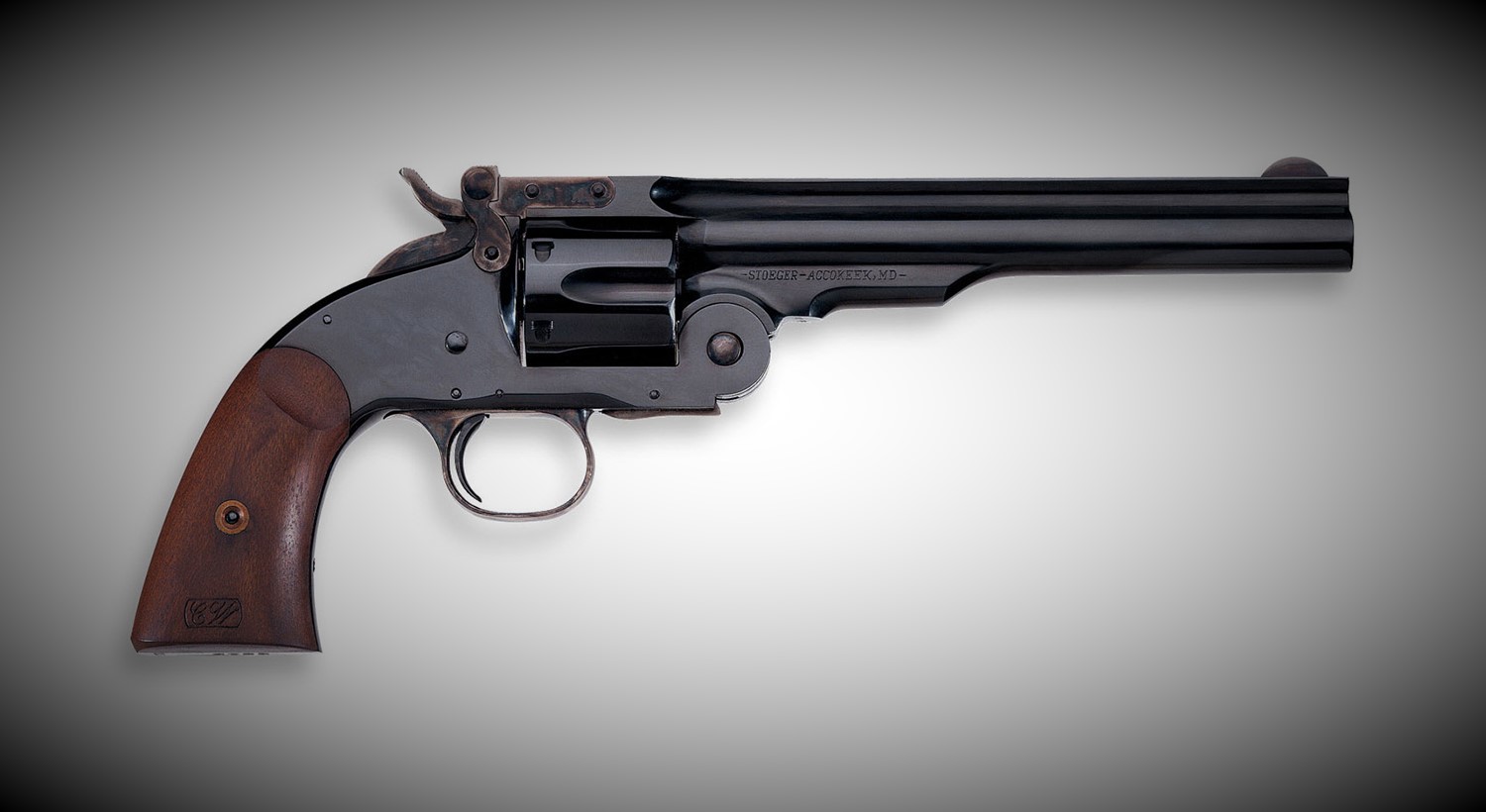
Specifications
| Cartridge | 45 Colt (Long Colt) |
| Capacity | 6 Round |
| Weight | 44.8 Ounce (2 pounds, 12.8 ounces) |
| Barrel Length | 7 Inches |
| Action Type | Revolver |
| Trigger Type | Single Action |
| Threaded Muzzle | No |
| Barrel Finish | Blued |
| Front Sight | Blade |
| Rear Sight | Notch |
| Frame Material | Steel |
| Grip Material | Wood |
| Frame Finish | Blued |
| Compensated | No |
| Grip Color | Walnut |
| Grip Style | Smooth |
Although Cimarron Firearms lays claims to the Number 3 Schofield Revolver 6-Round Blue under review, they are the importers and A. Uberti Srl. makes the revolver. A. Uberti Srl. Is headquartered in Brescia, Italy and has a U.S. Division in Accokeek, Maryland.
The Smith & Wesson Break-top revolvers have a fascinating history, a bit of which even included the Russians. My interest was not with the Russian model; however, as I wanted to stay within the United States and the Smith & Wesson No. 3 with a 7-inch barrel would be fitting for my collection of early revolver replicas by Uberti. However, and to be clear, the Smith and Wesson No. 3 under review is a replica of the 1877 New Model S&W No. 3 and not previous versions.
My collection includes historically significant (at least to me) cap and ball revolvers, cartridge conversions, and full cartridge models from Colt and Remington. The Smith and Wesson No. 3 would be the only Smith and Wesson revolver in the collection. I first set eyes on the Uberti “Schofield” over five years ago. I did not buy it then, as my collection was young and as yet defined. Even after I had put a modicum of definition to my collection, I knew that the Schofield revolver would be one of the last items in the collection (a Colt Paterson replica still escapes me), and that it would cap the collection. I happened to find this one through Midway for a decent price.
The Smith and Wesson No. 3 is a Schofield model, as many mistakenly call all Smith & Wesson break-top revolvers, and there are five variations of the No. 3 revolver. In 1877 (the year of this model), S&W discontinued production of its other Model 3s such as the American, Russian, and Schofield—in favor a new improved design called the New Model Number Three that used several features of the earlier versions. This new model has a longer cylinder allowing it to fire longer cartridges. Standard chambering was .44 Russian, although other calibers were offered on special order or in related models such as the .44-40 Frontier Model, the .32-44 & .38-44 Target Models, and the very rare .38-40 Winchester Model. The Smith & Wesson Model 3 was manufactured from 1870 to 1915. During that time, the Smith & Wesson Model 3 was used in ten countries and seven wars.
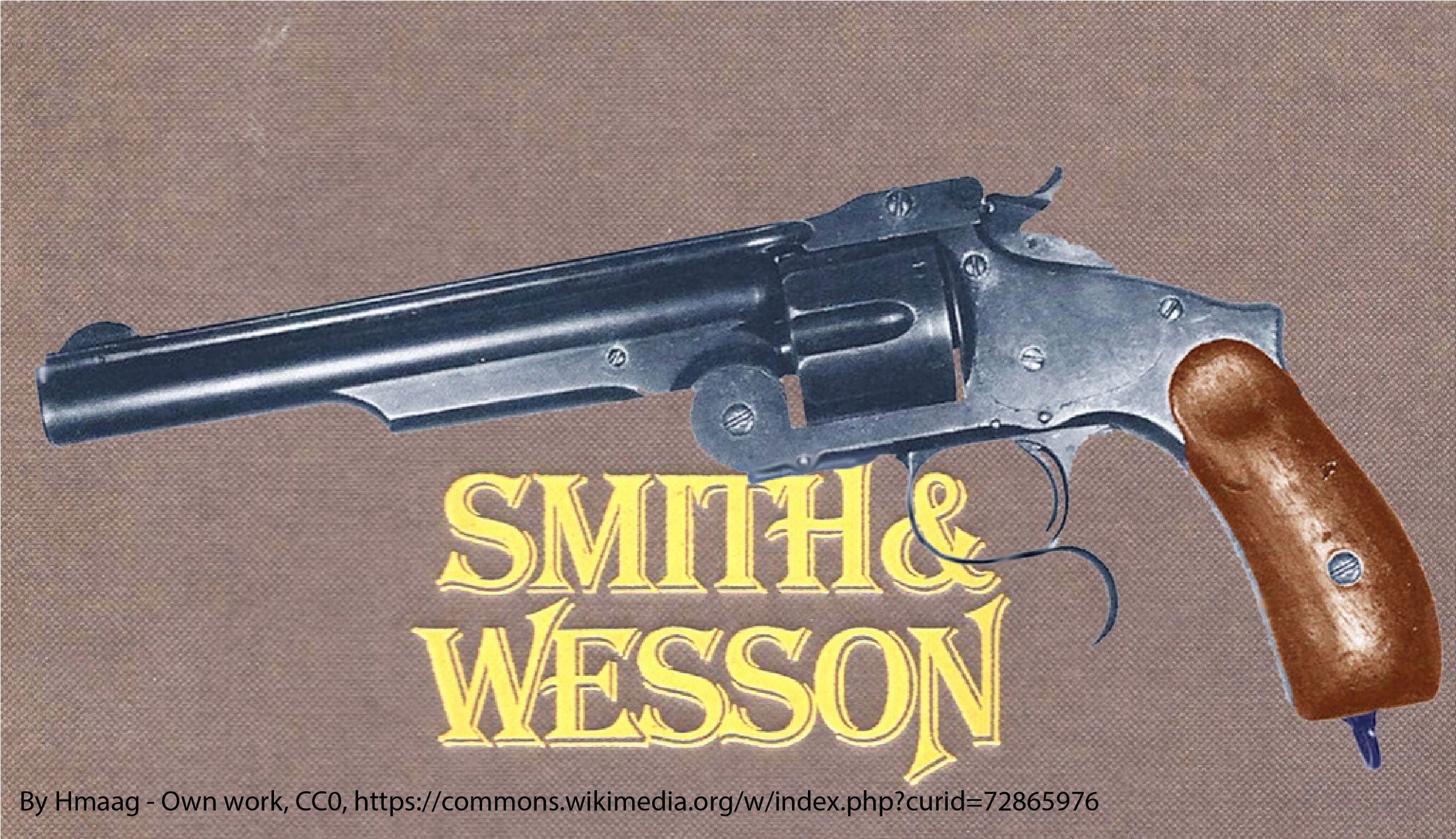
Smith & Wesson Russian Schofield Revolver
In the Uberti catalog, the model under review is the 1875 No. 3 Top Break 2nd Model, although 1877 is stamped on the firearm, although Wikipedia lists it as the New Model Number 3. Different names for the firearm vary among distributors.
In the day, the Smith & Wesson Model 3 was not the only break-top revolver. One of the most famous “break-top” revolvers is the Webley service revolver (and the Enfield revolver, a nearly identical design), used by the British military from 1889 to 1963. However, the American outlaw Jesse James used the 19th century Schofield Model 3 break-top revolver, and the Russian Empire issued the very similar .44 Russian caliber Smith & Wesson No. 3 Revolver from 1870 until 1895 thereby solidifying the Smith & Wesson No. 3 forever in the annals of firearms history.
While original Smith & Wesson No 3 revolvers can still be found, and at a healthy price I might add, the Uberti reproduction of this revolver brings a reasonable facsimile of this revolver into the hands of appreciators of such period firearms for a reasonable cost.
The Uberti version, imported by Navy Arms and Cimarron Firearms, has external dimensions generally like the original 2nd Model Schofield, but the barrel and top strap are considerably thicker, for additional strength. These replica Model 3 revolvers have lengthened cylinders to accommodate .45 Colt and .44-40 cartridges. Although there were some problems with the locking latch angles in early versions, these were corrected, or the revolvers were replaced. European reproduction Model 3 revolvers have changes made to their lock-work to meet import regulations.
The version that I have is chambered in .45 Colt to make it cartridge compatible with my other cartridge single-action revolvers.

In the hand, the CIMARRON NUMBER 3 SCHOFIELD is a handful, and at nearly three pounds it is far from being a lightweight. The feel of the revolver is, of course, different from any 1873 Colt SAA.
The bluing is excellent, as is the color-case hardened top latch mechanism, hammer, and trigger assembly.
The grip is fitted to the revolver very well and is not of the usual Uberti high-polished Walnut but is more natural in finish, which is something that I like. In fact, it is how I prefer the grips to be on these reproduction revolvers, as I like the natural feel of wood and not that of highly lacquered finishes, and because highly lacquered finishes would not be found on period revolvers.
The mating of parts is excellent, and the overall look of the Smith & Wesson No. 3 Schofield revolver is that of a sleek jaguar with a very striking forward-looking profile. The revolver seems to convey that whatever is being pointed at will not escape its focus. That 7” barrel is like looking down the hood of an old “Deusy” touring car that just seemed to go on forever.
Sighting is through a channel in the Stud Latch and the blade front sight. While not the best of sights, as if there were ever the best of sights on some of these old revolvers, the sights are adequate for the purpose of the firearm. The revolver does shoot a bit high, but otherwise is fine.
The single-action trigger is excellent; albeit, light. The trigger pull weight measures out at an average of three pounds, seven ounces over five pulls of the Lyman Digital Trigger Pull Gauge. That is definitely lighter than most single-action triggers found on Colt and Remington single-action revolvers, which have triggers that any 1911 operator would love to have. The trigger is slightly gritty when new but smooths out after several cylinders-full of cartridge are shot.
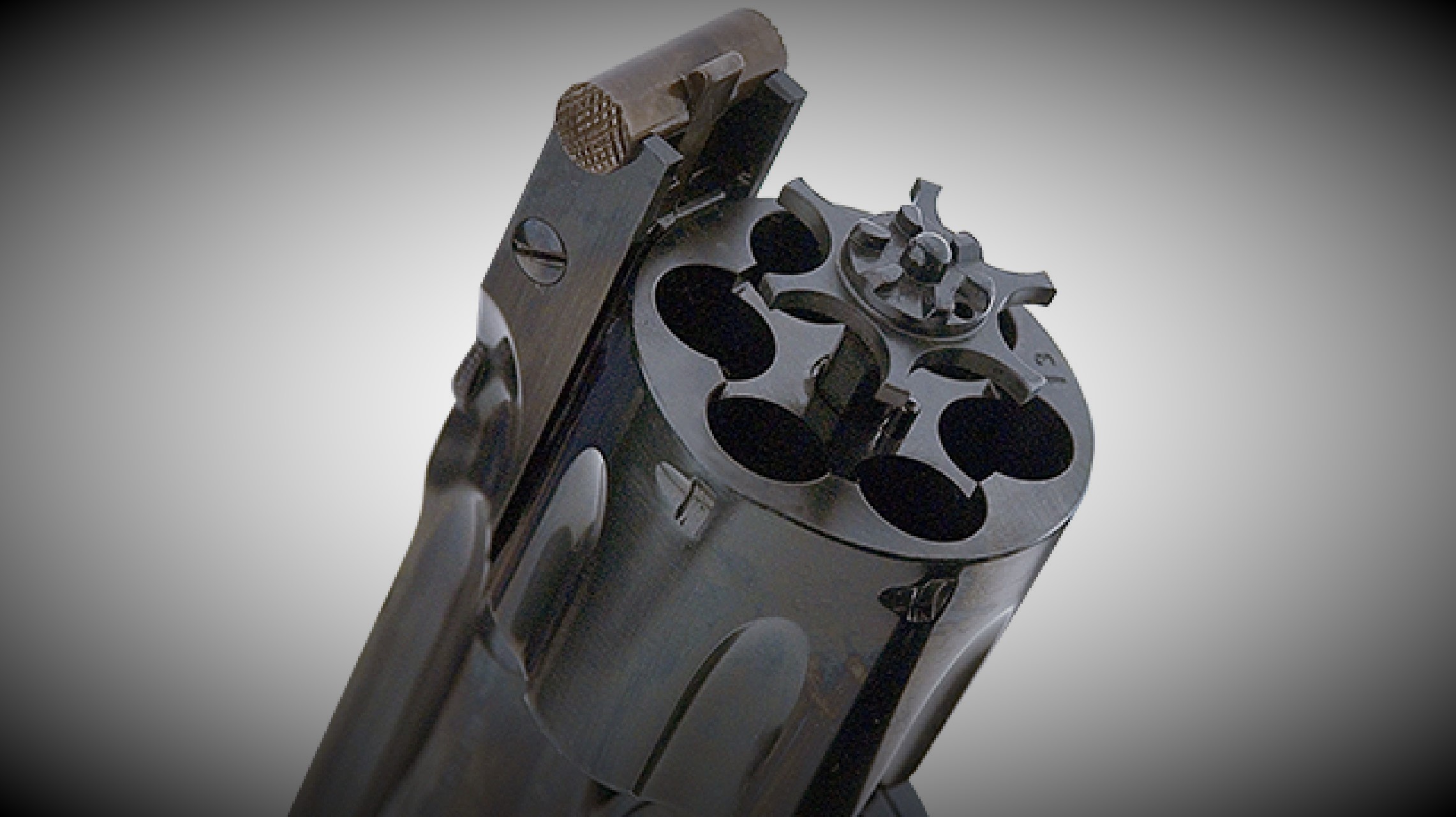
Early pre-Schofield Release Latch
Being a top-break, the manual of arms is quite different from the standard single-action revolver that is loaded and unloaded via a side gate. To unload the Smith & Wesson No. 3 revolver, point the gun in a safe direction. Draw the hammer back to the first cock position. Position the gun so the cylinder is facing downward, release the Stud Latch and completely open the gun. At this point all the cartridges will fall out towards the ground.
For the early model Smith & Wesson No. 3 revolvers, opening the action took two hands. In the later model, the Schofield model and New Model, the shooter could open the action using only the thumb of the shooting hand. The hammer was placed in the safety position and the thumb pressed down on the Stud Latch. A quick flick of the wrist would cause the front end of the revolver to rotate down. The wrist flick had to be of enough force to activate the extractor, which is used to empty the chambers of the cylinder. The cylinder was loaded weak hand while the strong hand would hold the gun and the reins of the horse being ridden (or just the revolver if dismounted). When loaded, the weak hand would close the front of the revolver and the shooter was back in action. It was possible to load multiple rounds at the same time, depending on the dexterity of the shooter. The Stud Latch was ambidextrous (yes, there were left-handed shooters in those days).
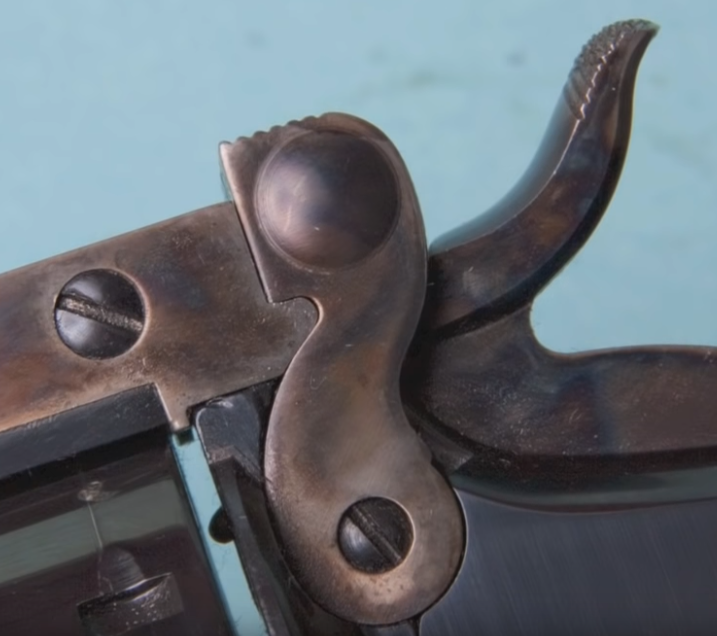
Late Model Schofield Release Latch
From Uberti:
“To load the revolver; keeping your finger out of the trigger guard and off the trigger, draw the hammer back to the first cock position which makes the cylinder free to rotate. Then, open the revolver as far as it will open until the ejector returns to its normal position in the cylinder. Make certain you have the exact caliber cartridges matching the exact caliber of the revolver. Then load one cartridge in each chamber. Before closing your revolver, make sure that the hammer is in first cock position. If the hammer is in full cock position (firing position) the firearm will not close. Do not insist on closing because the hand is not in its correct position. Be careful because you could break the hand. You should practice this loading function without any cartridges until you feel comfortable. Then, and only then, are you and your revolver ready for use.
To fire the revolver; Pull the hammer backward in firing position (full cock). Make sure it clicks into this rearmost position. The revolver is now ready to fire.
Never attempt to fire your revolver in any position except the full cock position. Attempting to pull the trigger in the safety position will strain the mechanism and make it unsafe. (It might even break if you are strong enough).
If your revolver is in the full cock position and you change your mind and don’t want to shoot, carefully follow these instructions:
- Point the revolver in a safe direction.
- Take your trigger finger out of the trigger guard and put this finger on the side of the frame.
- Release the stud latch and rotate the barrel fully open.
- Remove all cartridges and empty casings from your firearm.
- Put your trigger finger on the trigger and your thumb on the hammer.
- Pull the trigger backward and hold it while lowering the hammer. After the hammer has passed the full cock position (firing position) release the trigger and continue to lower the hammer until it clicks into the first cock position.
Before opening and closing your firearm MAKE SURE THE HAMMER IS IN THE SAFETY POSITION. With the hammer in this position, the safety mechanism is activated.
Make sure your revolver is always in the safety position when transporting or when you are not actually firing.
You must learn this procedure with an unloaded firearm until you feel confident and are familiar with the handling.
Only when you feel really confident should you think about using live ammunition.”
Safety
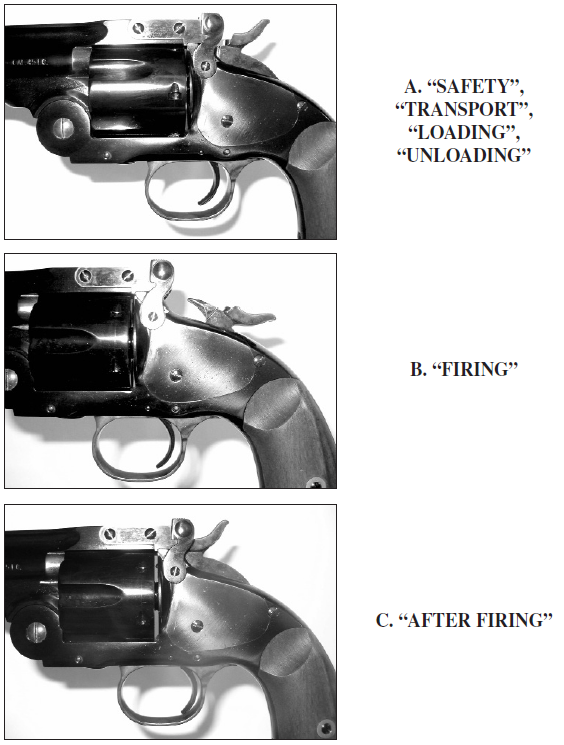
Although the Smith & Wesson was a break-top revolver, safety remained and still does reman the primary consideration when handing a firearm. The Uberti reproduction of the Smith & Wesson no. 3 revolver, have a hammer block safety in the frame. To activate the hammer safety block, pull the hammer backward until you hear the first click. If fully cocked, lower the hammer into the safety position while briefly pulling the trigger. With the hammer in this position, the safety mechanism is activated. This patented device places a steel insert between the hammer and the frame and is designed to prevent the gun from firing accidentally. When the gun is loaded and not being used, always use the hammer block safety or position the hammer on an empty cylinder.
The Schofield’s hammer cocks with three clicks, The first one, as discussed above, is as the hammer starts rearward (presumably caused by the internal hammer block safety added by Uberti). The first click is both tactile and audible. The second is as the hammer reaches the loading notch (quarter cock) when the cylinder spins freely. The second notch is a ‘touch-n’-feel’ position, as it is not as tactile and audible as the first notch. The third, and most pronounced notch, is when the hammer reaches the full cock position.
In the days of the original Smith & Wesson No. 3, the “Carry 5” principle existed just the same as it did for the SAA counterparts. This is the method that I prefer to follow, as I not trust “half-cock” 100% and I am used to lowering the hammer on an empty chamber.
- Load five adjacent chambers, leaving one empty chamber.
- Line up the empty chamber to the left of the barrel.
- Close the action.
- Pull the hammer to the full-cock position
- Pull the trigger backward and hold it while lowering the hammer. After the hammer has passed the full cock position (firing position) release the trigger and continue to lower the hammer completely, then pull the hammer back until it clicks into the first cock position. This places the hammer over an empty chamber and in the ‘safety’ position.
Incidentally, the Schofield can be opened with the hammer in the full cock position. This allows a shooter who has cocked the hammer, but not fired a loaded gun to easily return the revolver to a safe condition. Just open the revolver part way (not far enough to extract the cartridges) and use a thumb to lower the hammer all the way down. Then bring the hammer back to the safety position and close the revolver.
Although I may be at the range and not in the saddle, handling these single-action revolvers, even though they are reproductions, the same safe way each time help mitigate errors and unintentional discharges.
Handling

The Smith & Wesson No. 3 revolver is a different breed of single-action animal that some find most difficult to shoot well. Due to the angle, distance of the grip, and trigger reach, some find the Smith & Wesson No. 3 revolver unwieldly to shoot, and it can be that.
Shooting these reproductions of early revolvers makes me appreciate what we have today. As advanced the Smith & Wesson was at the time, loading a full cylinder while sitting atop a horse during battle had to be a challenge. Now, if speed loaders had been available back then…
With fifty rounds of Georgia Arms 250-grain Round Nose Flat Point “Cowboy” ammunition rated to travel at 725 feet per second at the muzzle to start this initial evaluation, I was really looking forward to shooting the Smith & Wesson No. 3 revolver, as I have never shot one before. Even though I had gone through the loading and unloading procedures at home (using A-Zoom .45 Colt Snap Caps), I practiced the procedure several more times before loading.
The hammer spur is high on this revolver. Cocking the hammer brings it low on the back of the receiver. De-cocking the hammer takes a shift in hand position. The Smith & Wesson No. 3 has a long and flowing backstrap, which is a bit hard to get used to. A person with small hands or short fingers might have a problem shooting this revolver. Moreover, a small-handed person may have trouble lowing the hammer manually without using two hands to do so.
Unlike with the Russian version of the Model 3, there is roll to the recoil with a top break. You know you are shooting a powerful round and a healthy grip helps to mitigate the roll. To really appreciate these reproductions, I would love to be able to handload these cartridges with black powder, but I am satisfied with using modern powders.
With that said, and because the Smith & Wesson No. 3 is a top break revolver, ammunition should be wisely selected. I like shooting all my period pieces using Georgia Arms “Cowboy” ammunition (or similar-rated ammunition from other manufacturers) that is rated at 725 fps or so. I am looking simply looking to put small holes in paper target and that does not take a lot of energy. This mild load makes shooting any of my period pieces a pleasurable experience. I save the heavier loads for more modern rifles and handguns.
With three-pound and 7-ounce trigger pull, I found the Smith & Wesson No. 3 a challenge to shoot well. The challenge being to make sure I was on the target before even touching the trigger. If only I had this trigger on some of my 1911 pistols.
The Smith & Wesson No. 3 is one of the more accurate of the reproduction revolvers that I have fired. Take a 6 o’clock hold on what you want to hit at 10-yards and a hole magically appears if you do your part. All my shooting was done one-handed, as it should be with these reproductions of early revolvers. Recoil is so mild as to be negligible.
Range day with a good single-action revolver always helps me achieve ataraxy. Life slows just a wee bit for me.
The Carry Factor
It should be obvious that modern carry of a reproduction Smith & Wesson No. 3 revolver for the purpose of self-defense would be out of the question, but I would consider that situational.
I agree that Smith & Wesson No. 3 revolver might not be the correct firearm to carry concealed to your local Wal-Mart, but in areas where you are the Wal-Mart and four-legged furry carnivores are the shoppers, having one or two in decent holsters really would not be that farfetched. However, full-load .45 Colt would be a better choice over ammunition made for SASS. The .45 Colt cartridge was considered the power-house load of its day, with a black-powder cartridge. The original black-powder loads called for 28 to 40 grains (1.8 to 2.6 g) of black powder behind a 230-to-255-grain (14.9 to 16.5 g) lead bullet. These loads developed muzzle velocities of up to 1,050 ft/s (320 m/s). Because of this power and its excellent accuracy, the .45 Colt was the most-used cartridge at the time of its introduction, succeeding the .44 WCF (or the .44-40 Winchester). The Georgia Arms 250-grain flat-nose round-point load that I shoot, at 725-feet per second, is acceptable for “Cowboy” shooting and range work; however, I would rather have something healthier when in the field, something like Underwood Ammunition 45 Colt (Long Colt) +P 250 Grain Hornady XTP Jacketed Hollow Point @ 1400 feet per second, and I would prefer to shoot these loads in more modern firearms; a Ruger Blackhawk or Redhawk chambered in .45 Colt would be a more suitable carry with this ammunition. That is not to say that the Uberti could not handle a bit hotter ammunition than “cowboy” loads, as the revolvers are tested to three times the specified rating. It is to say that a more modern revolver capable of handling modern full-power cartridge might be a better choice. I value my replicas too much to subject them to heavy, or even standard, loadings. I also value my skin and would be more likely to carry a modern revolver in a substantial modern magnum caliber during my outings, which has become less and less. Nevertheless, higher loading call for more modern firearms, in my opinion.
For a good carry rig, you might want to check out Chisholm’s Trail Schofield holster (shown below)
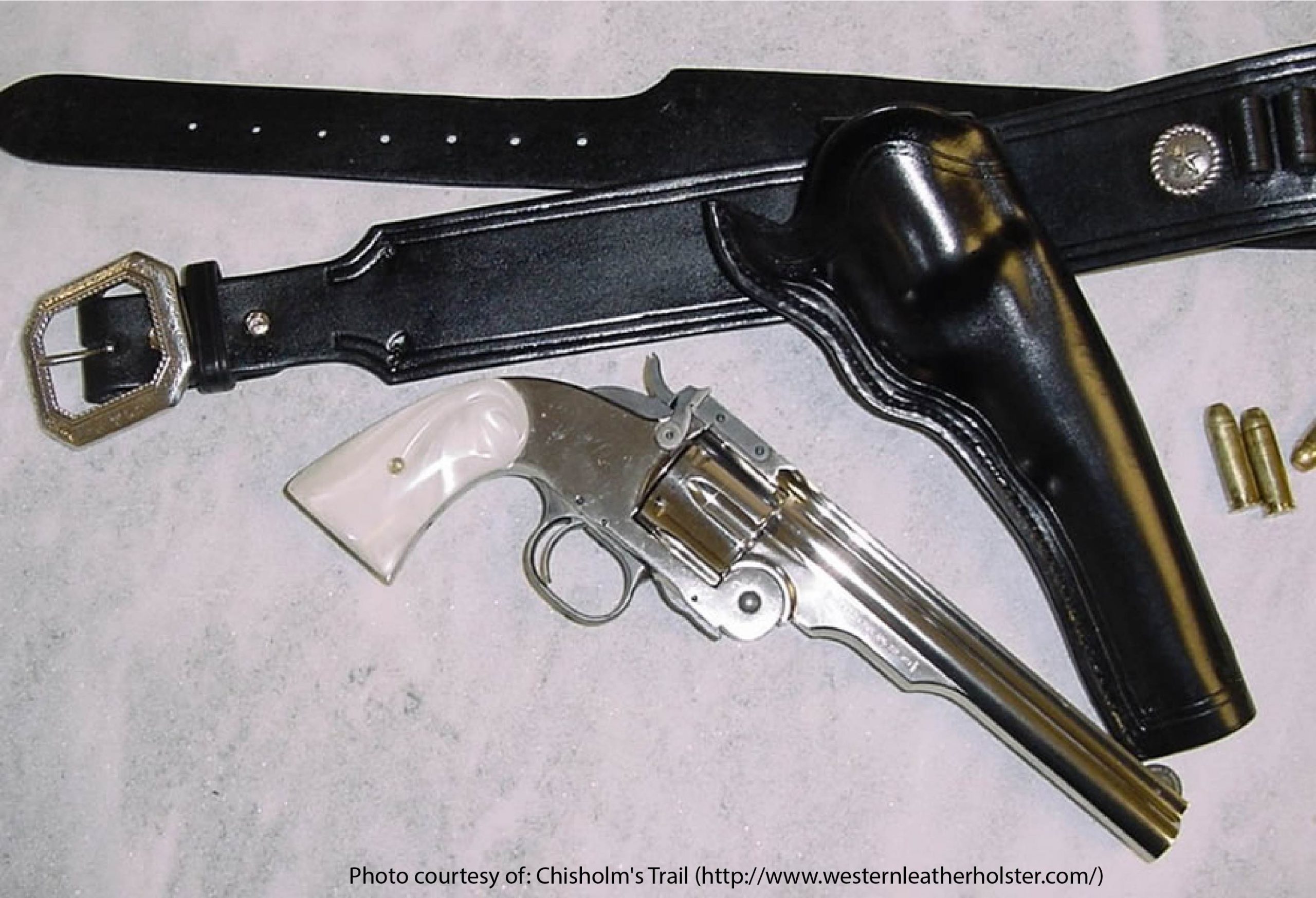
Two other sources are; The Last Best West and its Threepersons Schofield Holster, and the K.C. Miles Leatherworks who carries an excellent Schofield holster.
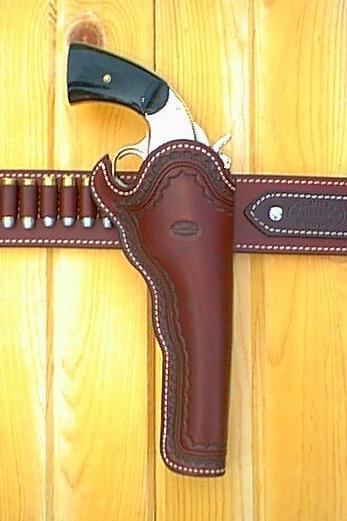
Last Best West Schofield Holster
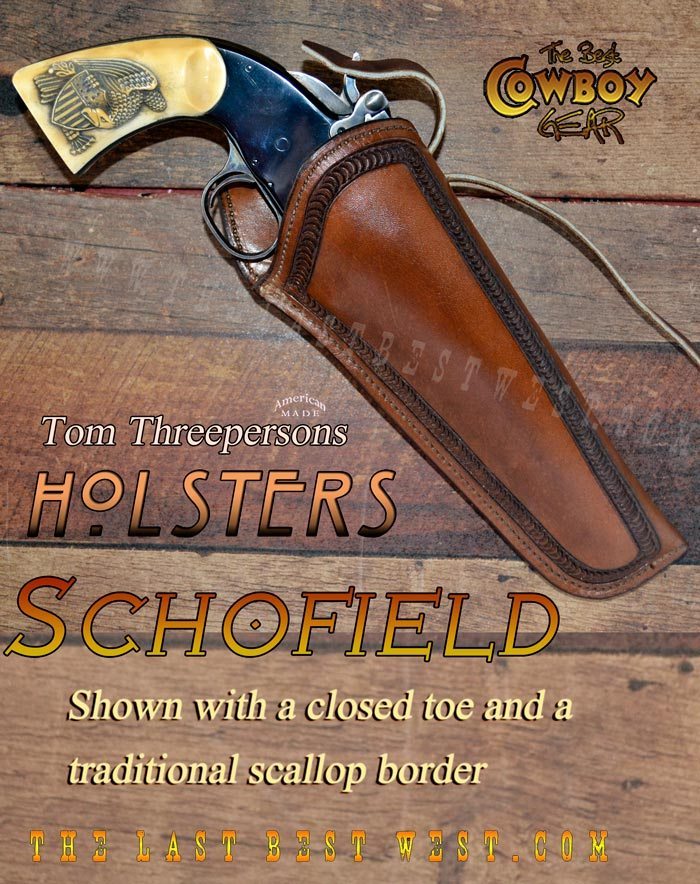
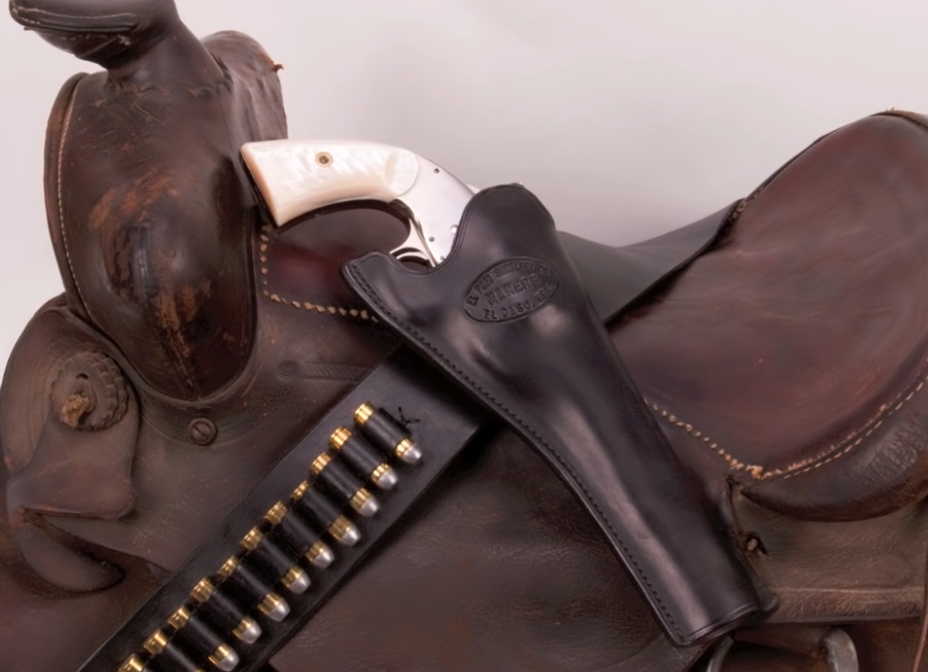
El Paso Saddlery Schofield Holster
Breaking it Down
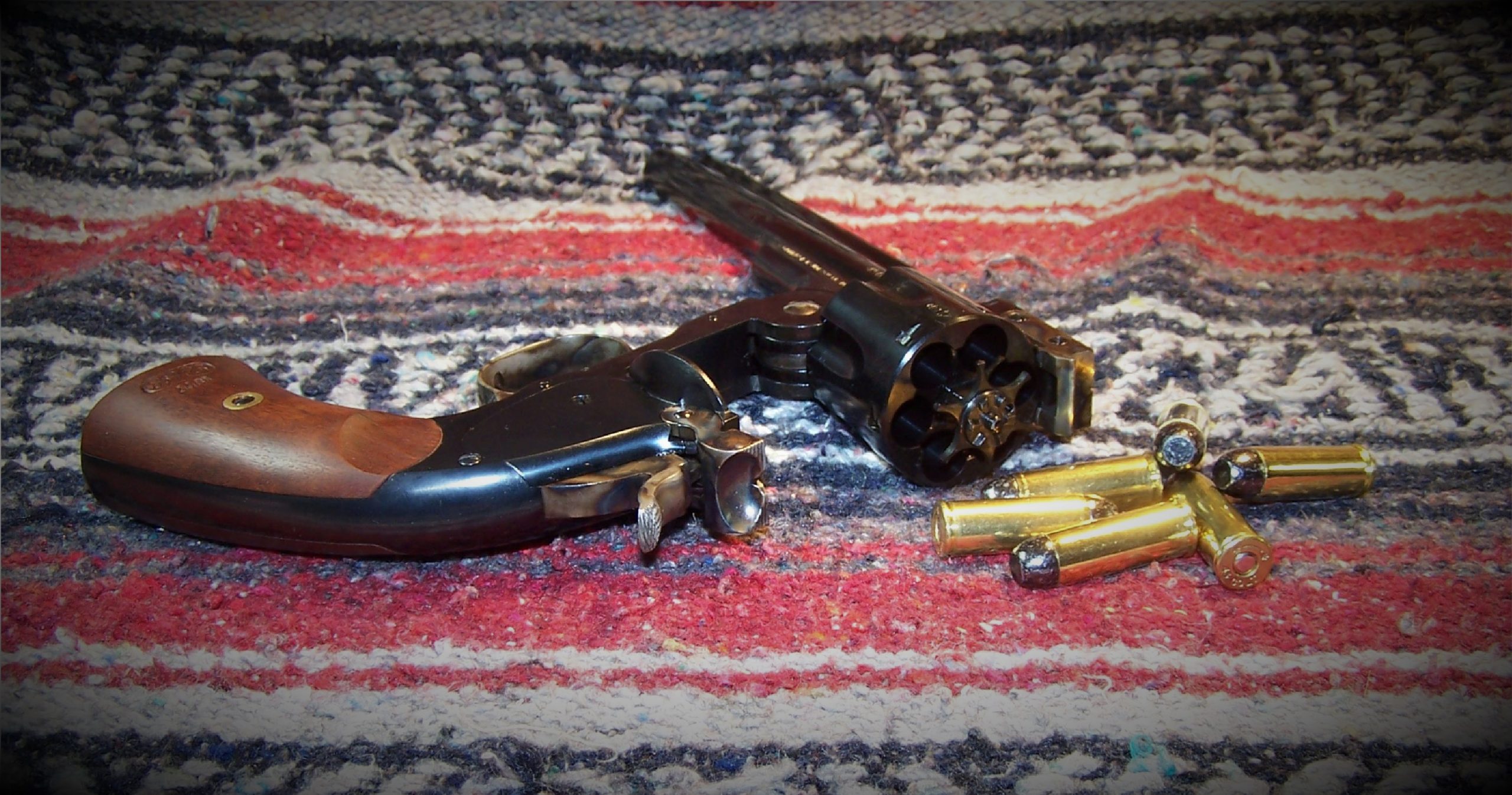
The Smith & Wesson No. 3 revolver is an iconic revolver that was recognized for the top-break loading and unloading in a world of side-gate loaders. Quick to load and quicker to unload, the Smith & Wesson No. 3 was a much sought-after revolver by the military and the civilian populace, of which good and bad populated both.
Since the frame is in two parts; however, held together by a latch on the top rear of the cylinder, top-break revolvers could not and cannot handle high pressure or “magnum”-type rounds. Top-break revolver designs are antediluvian for the most part in this modern world, but the Smith & Wesson No. 3 revolver remains, as does the .455 Webley, a keynote in firearms history.
In all, there were five models of the Smith & Wesson No. 3; First Model Schofield, Second Model Schofield, New Model Number 3, Australian Model, and the Smith & Wesson .44 Double Action Frontier.
Jessie James owned a brace of them. John Wesley Hardin, at the age of 21, used a nickel-plated, ivory gripped, Old Model Russian to kill Brown County Deputy Sheriff (Charley) Webb in 1874 in Comanche, Texas. Wyatt Earp and others also owned these break-top revolvers and it is chronicled that Wyatt Earp used a Smith & Wesson Model 3 and not a Colt at the gunfight near the OK Corral. These were people who, while working both sides of the law at times, were highly dependent on their firearms to ensure staying on the green side of the grass, and it seems that the Smith & Wesson No. 3 revolver was quite capable in doing that. While I cannot afford a real Smith & Wesson No. 3 revolver, I am proud to say that I can at least own a taste of a time that I should have been part of with the Uberti/Cimarron Number 3 reproduction Schofield Revolver.
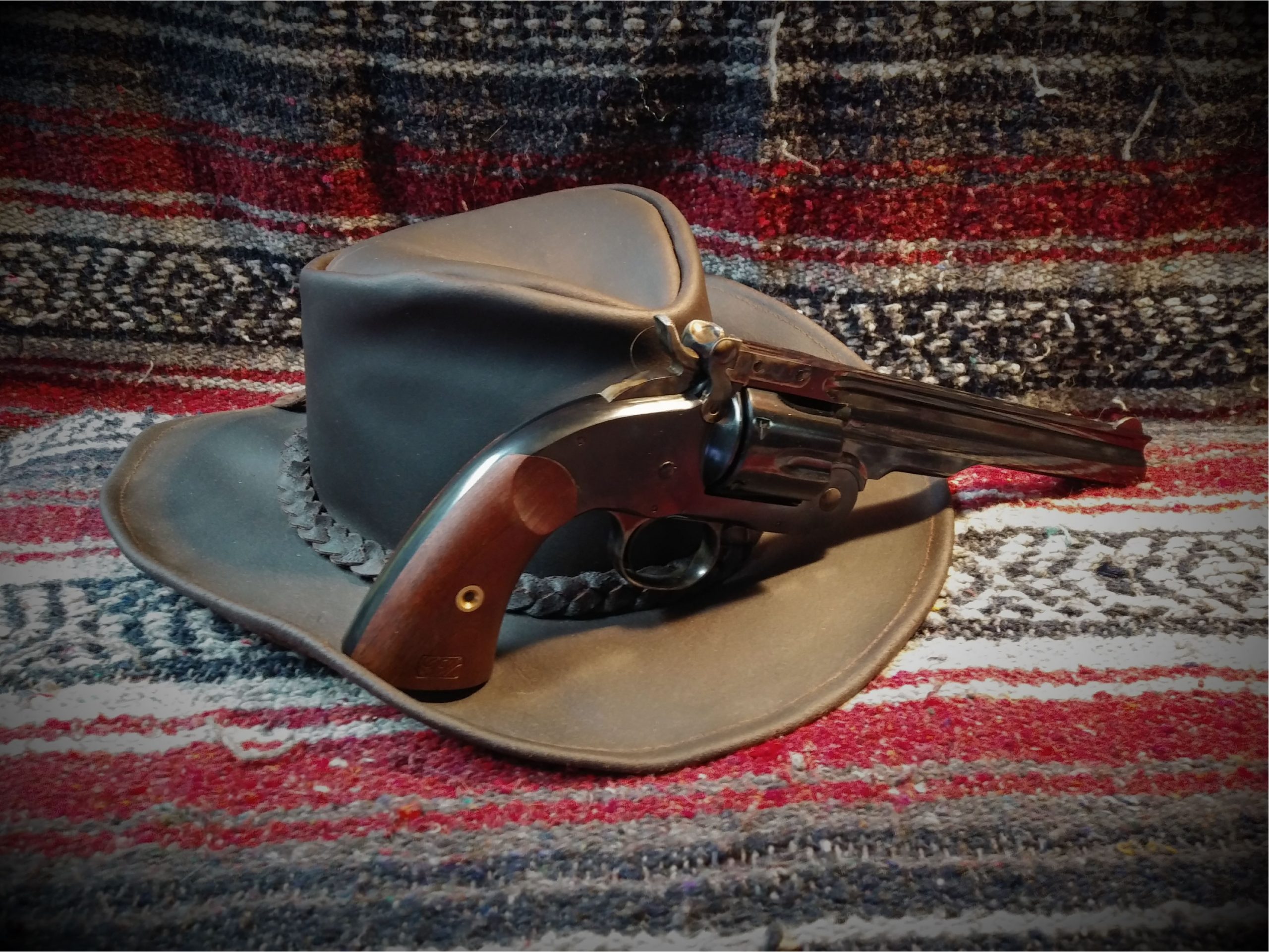
The Uberti Top Break Revolver brings us but a brief glimpse of firearms history that cannot be re-written, although some would try to eradicate it entirely. And if we let them have their way, they will.
If you are into “Old West” firearms, the Uberti Smith & Wesson No. 3 reproduction of the No. 3 Russian Top Break New Model, or the 1875 No. 3 Top Break 2nd Model in 7″, 5″, and 3.5″ versions could fit your fancy if you fancy it could. Note that the 1875 No. 3 Top Break 2nd Model in 7″, 5″, and 3.5″ versions are of the Schofield (top latch) design with just varying barrel lengths. Depending on the supplier (Cimarron or Taylors), the description of these revolvers may vary.
Resources
Smith & Wesson Model 3: https://en.wikipedia.org/wiki/Smith_%26_Wesson_Model_3#First_Model_Schofield
.45 Schofield: https://en.wikipedia.org/wiki/.45_Schofield
Shooting the Schofield Revolver.mov: https://www.youtube.com/watch?v=Td8vfIfBx_c
Smith and Wesson Schofield vs Colt Peacemaker: https://www.youtube.com/watch?v=ZrqPGO1-aMQ
S&W Schofield No. 3 Revolver Vs Colt Single Action Army (Uberti): https://www.youtube.com/watch?v=byxQW85OycY
![]()

